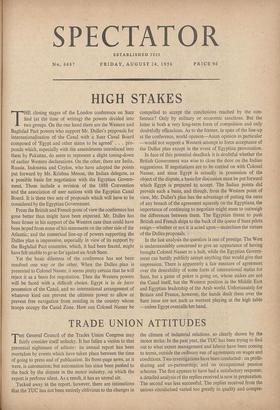TRADE UNION ATTITUDES
THE General Council of the Trades Union Congress may fairly consider itself unlucky. It has fallen a victim to that perennial nightmare of editors : its annual report has been overtaken by events which have taken place between the time of going to press and of publication. Its front-page news, as it were, is automation; but automation has since been pushed to the back by the dispute in the motor industry, on which the report is perforce silent. As a result, it has an unreal air.
Tucked away in the report, however, there are intimations that the TUC has not been entirely oblivious to the changes in the climate of industrial relations, so clearly shown by the motor strike. In the past year, the TUC has been trying to find out to what extent management and labour have been coming to terms, outside the ordinary run of agreements on wages and conditions. Two investigations have been conducted : on profit- sharing and co-partnership; and on occupational pension 'schemes. The first appears to have had a satisfactory response; a detailed analysis of the replies received is now in preparation. The second was less successful. The replies received from the unions circularised varied too greatly in quality and compre- hensiveness to justify formal analysis; instead, the Government is to be asked to undertake a full inquiry 'as an urgent task.'
But at least the TUC's investigation did reveal one valuable piece of information; almost without exception, the unions which replied stated that their members were in favour of occupational pensions schemes, particularly if they are negotiated with (rather than imposed by) management.
This information is significant; another straw in the wind blowing away from old-style trade unionism, based as it was on the assumption that workers' loyalties followed the—horizontal —lines of the class structure. Now, the trend is towards vertical integration : through co-partnership, profit-sharing, occupa- tional pensions schemes, joint consultation, and so on. New loyalties are being created—and new self-interests.
This development undoubtedly represents a threat to the trade union movement, which has drawn so much of its strength in the past from the assumption that the boss is the enemy. But the motor industry strike made it clear that this division no longer exists. In spite of the still common reluctance of employers, partly from inertia, partly from prejudice, to realise the advantages of giving the worker a formal stake in his firm, a new concept of common interest between worker and employer has arisen, strong enough to split the workers when the strike was called.
It would be unfair to criticise the TUC report for not paying more attention to this. The document is more concerned to relate what has been done in the past year than to discuss what needs to be done in the next. But there can certainly be no excuse for the TUC if no lead is given when Congress meets next month. Plenty of delegates will try to turn the trade union movement back into its old ways, its old class-war attitudes, on the pretext of the need to preserve working-class unity. But such a regression could now only destroy what unity remains. Whether the TUC has in it men who have the courage to face these realities, and to act on them, is yet to be shown.



























 Previous page
Previous page